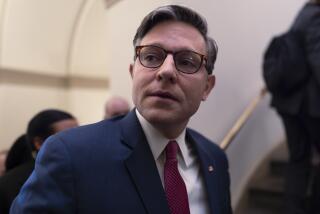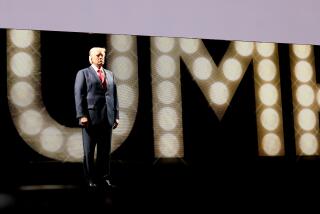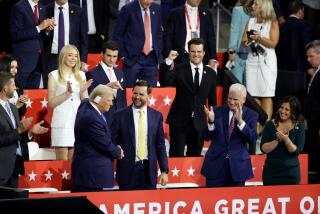Despite talk of GOP unity, Trump’s programs face fight from Republican budget hawks
Reporting from Washington — Paul D. Ryan appears to be cruising toward reelection as House speaker, but his bold promise Tuesday of a new “dawn” for GOP unity — Republican lawmakers found “Make America Great Again” hats waiting on their chairs at a morning meeting — does not hide the deep divisions that remain.
There’s a clash growing between Donald Trump’s new vision of the Republican Party, which includes increased spending on several fronts, and budget hawks like Ryan and the GOP’s small-government Freedom Caucus, whose ideology had previously dominated the party.
It’s not just that the president-elect has promised costly big-ticket items — beefing up the military, building a wall along the border with Mexico and improving the social safety net, including healthcare.
Trump has also shown little interest in Ryan’s signature budget-slashing proposals — such as cutting entitlement spending on Medicare and Medicaid — which had long been central to the GOP’s plan for reducing deficits.
In fact, very little of what Trump promised to do during the campaign involved cutting government spending. Rather, he spoke of investing in the nation, creating jobs, and he once proudly proclaimed himself “the king of debt” in his business dealings.
Ryan says he now talks to Trump every day, despite their on-again, off-again relationship and warnings that Ryan might face a move to oust him as speaker during Tuesday’s internal GOP vote.
Instead, House Republicans unanimously agreed Tuesday to nominate the Wisconsin Republican for another two-year term, rewarding his efforts to unify the party. The final House vote will take place in January.
But Ryan acknowledged that they are only beginning to work through the details of a unified Republican agenda.
“It’s going to take time to figure out exactly what bill comes where and how it all adds up,” Ryan said.
The first clash may come over Trump’s call for a $1-trillion infrastructure program. Even if Trump relies on private investment, as his advisors have suggested, the notion of using government to prime the pump to create jobs stunned many conservatives when it received top billing on election night.
Scope of Donald Trump’s falsehoods unprecedented for presidential candidate »
Dan Holler, spokesman at the conservative Heritage Action for America, was taken aback as he watched Trump’s victory speech and the president-elect spoke of his “beautiful” program for new bridges, roads, airports and schools. To many that sounded more like the dream of big-spending Democrats than the Republican just elected to the White House.
“It would be a mistake to think that’s what the people were clamoring for,” said Holler, whose influential group tries to hold the line against spending. “As if that is the main message of the campaign — that we need a massive stimulus.”
Indeed, a week before election, when most still thought Hillary Clinton would win, GOP officials were preparing to attack the Democratic nominee’s own, much smaller infrastructure program as wasteful and unnecessary.
On Tuesday, former House Speaker John A. Boehner, himself a casualty of GOP infighting, referred to Trump as a friend, but also “barely Republican.”
The battle over spending is just one of the challenges that lie ahead as Republicans adjust to fact that they have now achieved what they long sought: Republican control of the White House and Congress for the first time in a decade.
Because Trump doesn’t neatly align with any previous strain of the GOP, it will only confound the job facing congressional leaders like Ryan.
“There’s probably going to be a learning curve as [Republicans] transition from opposing the policies of Democrats to implementing a conservative agenda,” said Michael Steel, a Republican strategist and former top aide to Boehner.
“There’s no question this is a huge step into the unknown,” he said. “They are building an airplane while in flight.”
In that sense, Trump’s election won’t end the civil war between Republicans on Capitol Hill. In fact, it may only complicate matters by adding a new front in their internal battle — a Republican-led White House.
To be sure, Trump and the party share some goals — repealing Obamacare, cutting taxes and reducing regulations.
And Ryan is trying hard to steer the conversation with Trump to the House GOP’s “Better Way” agenda — his blueprint for small-government.
He said recently that the effort to repeal Obamacare should also tackle reforms to Medicare and Medicaid.
Trump has given nod to the document, but it is unclear how broadly it might be adopted by the new administration. Trump has often spoke of protecting entitlement programs, rather than scaling them back.
The possibility for friction between Congress and the White House is only made worse by the fact that Trump named as his top strategist Stephen K. Bannon, the Breitbart News head who previously declared war on GOP establishment leaders like Ryan.
Also, Trump is facing his own pressure to deliver on election promises.
“The people Trump spoke to, who helped him get elected – ‘the forgotten people’ – they’re going to be looking for results,” said Rory Cooper, a Republican strategist who was a top aide to former Majority Leader Eric Cantor. “There aren’t excuses anymore. You can’t blame it on divided government.”
And at the end of the day, Trump may have the upper hand, given his victory.
“It’s not a power sharing arrangement,” said Craig Shirley, a Republican strategist who has written extensively about President Reagan. “Trump is the head of the party — it is his party now.”
The Trump administration may encounter the steepest resistance from the Freedom Caucus, which, before Trump, was the most powerful insurgent faction inside the GOP, leading the charge against Boehner and in the budget wars against Obama administration.
The caucus of several dozen lawmakers was divided over whether to support Trump’s candidacy and it’s unclear how much of a honeymoon they will give the new president. Already some members who backed Trump are warning that deficit spending may be a bridge too far.
“There’s Democrats and Republicans who believe deficits don’t matter,” said Republican Rep. Warren Davidson, a Trump backer and one of the newest Freedom Caucus members, who took over Boehner’s Ohio district. “There’s no one in the Freedom Caucus that stands for that.”
Rep. Charlie Dent (R-Penn.), a key moderate, cautioned it was too soon to declare an end to GOP in-fighting. “The dynamics that we’ve been dealing with all session need to change,” Dent said. “Whether they will change or not is still a bit of an open question.”
For the moment, Ryan seems to be navigating between the party’s factions, easily winning Tuesday’s nomination vote in the House GOP conference.
Rep. Kevin McCarthy of Bakersfield was elected to serve another term as majority leader.
A similar outcome is expected across the Capitol on Wednesday when Senate Majority Leader Mitch McConnell of Kentucky stands for reelection as party leader.
Even so, the final vote could still prove difficult for Ryan when the new Congress convenes in January. Ryan was slow to embrace Trump. But in the final days of the election, the potential for Republicans to sweep control of the House, Senate and White House drew him in.
“I’m not looking backward, I’m looking forward,” Ryan said Tuesday. “I’m looking for how we make this work for the American people.”
Twitter: @LisaMascaro
ALSO
‘Believe me’: People say Trump’s language is affecting political discourse ‘bigly’
Trump’s rise draws white supremacists into political mainstream: ‘I am winning,’ says David Duke
Harry Reid is not on the ballot. But the race in Nevada is his last stand
Live coverage from the campaign trail
UPDATES:
2:05 p.m.: This article was updated with additional reaction.
This article was originally published at 12:35 p.m.
More to Read
Get the L.A. Times Politics newsletter
Deeply reported insights into legislation, politics and policy from Sacramento, Washington and beyond. In your inbox three times per week.
You may occasionally receive promotional content from the Los Angeles Times.











